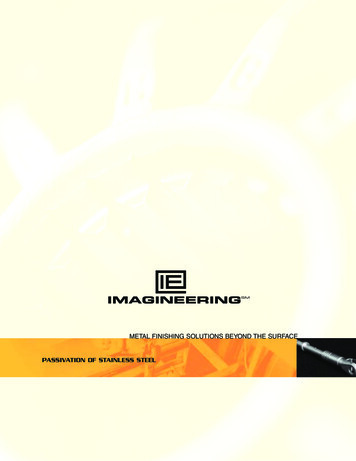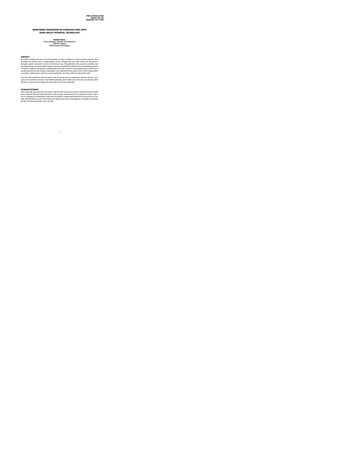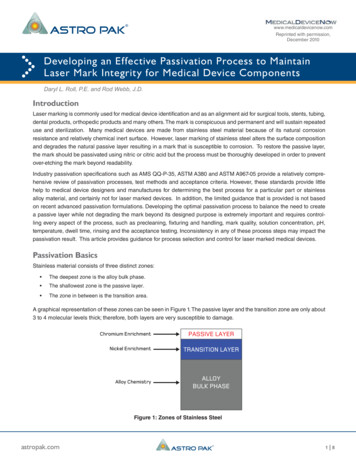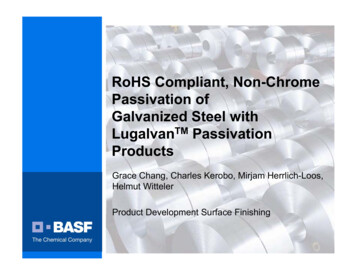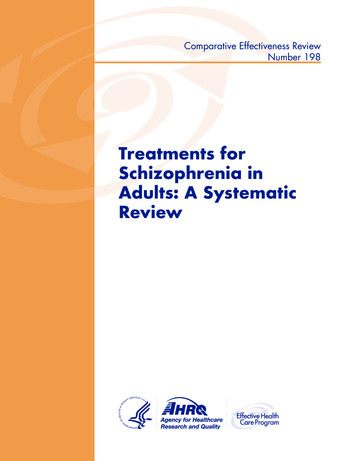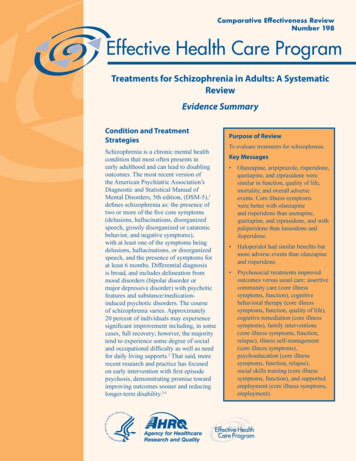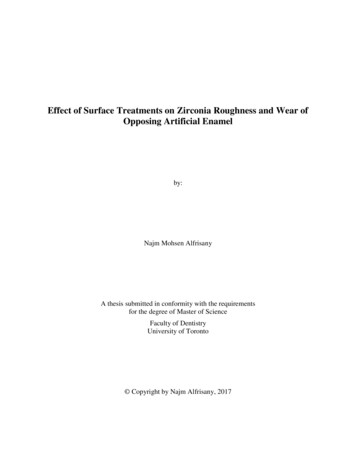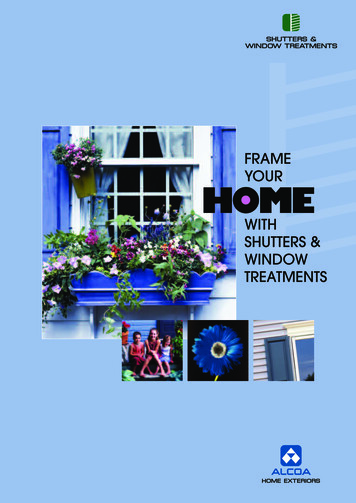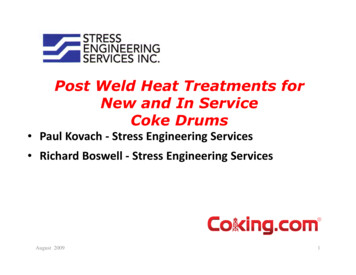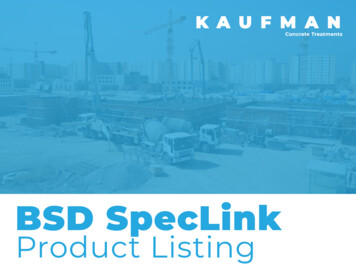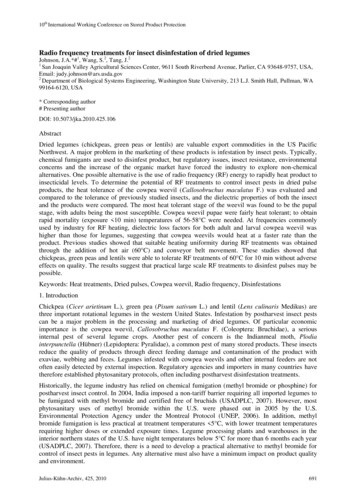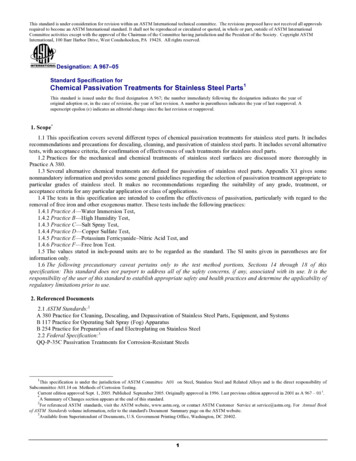
Transcription
This standard is under consideration for revision within an ASTM International technical committee. The revisions proposed have not received all approvalsrequired to become an ASTM International standard. It shall not be reproduced or circulated or quoted, in whole or part, outside of ASTM InternationalCommittee activities except with the approval of the Chairman of the Committee having jurisdiction and the President of the Society. Copyright ASTMInternational, 100 Barr Harbor Drive, West Conshohocken, PA 19428. All rights reserved.Designation: A 967–05Standard Specification forChemical Passivation Treatments for Stainless Steel Parts1This standard is issued under the fixed designation A 967; the number immediately following the designation indicates the year oforiginal adoption or, in the case of revision, the year of last revision. A number in parentheses indicates the year of last reapproval. Asuperscript epsilon (ε) indicates an editorial change since the last revision or reapproval.1. Scope*1.1 This specification covers several different types of chemical passivation treatments for stainless steel parts. It includesrecommendations and precautions for descaling, cleaning, and passivation of stainless steel parts. It includes several alternativetests, with acceptance criteria, for confirmation of effectiveness of such treatments for stainless steel parts.1.2 Practices for the mechanical and chemical treatments of stainless steel surfaces are discussed more thoroughly inPractice A 380.1.3 Several alternative chemical treatments are defined for passivation of stainless steel parts. Appendix X1 gives somenonmandatory information and provides some general guidelines regarding the selection of passivation treatment appropriate toparticular grades of stainless steel. It makes no recommendations regarding the suitability of any grade, treatment, oracceptance criteria for any particular application or class of applications.1.4 The tests in this specification are intended to confirm the effectiveness of passivation, particularly with regard to theremoval of free iron and other exogenous matter. These tests include the following practices:1.4.1 Practice A—Water Immersion Test,1.4.2 Practice B—High Humidity Test,1.4.3 Practice C—Salt Spray Test,1.4.4 Practice D—Copper Sulfate Test,1.4.5 Practice E—Potassium Ferricyanide–Nitric Acid Test, and1.4.6 Practice F—Free Iron Test.1.5 The values stated in inch-pound units are to be regarded as the standard. The SI units given in parentheses are forinformation only.1.6 The following precautionary caveat pertains only to the test method portions, Sections 14 through 18 of thisspecification: This standard does not purport to address all of the safety concerns, if any, associated with its use. It is theresponsibility of the user of this standard to establish appropriate safety and health practices and determine the applicability ofregulatory limitations prior to use.2. Referenced Documents2.1 ASTM Standards:2A 380 Practice for Cleaning, Descaling, and Depassivation of Stainless Steel Parts, Equipment, and SystemsB 117 Practice for Operating Salt Spray (Fog) ApparatusB 254 Practice for Preparation of and Electroplating on Stainless Steel2.2 Federal Specification:3QQ-P-35C Passivation Treatments for Corrosion-Resistant Steels1This specification is under the jurisdiction of ASTM Committee A01 on Steel, Stainless Steel and Related Alloys and is the direct responsibility ofSubcommittee A01.14 on Methods of Corrosion Testing.Current edition approved Sept. 1, 2005. Published September 2005. Originally approved in 1996. Last previous edition approved in 2001 as A 967 – 01 1.*A Summary of Changes section appears at the end of this standard.2For referenced ASTM standards, visit the ASTM website, www.astm.org, or contact ASTM Customer Service at service@astm.org. For Annual Bookof ASTM Standards volume information, refer to the standard's Document Summary page on the ASTM website.3Available from Superintendent of Documents, U.S. Government Printing Office, Washington, DC 20402.ε1
A 9673. Terminology3.1 Definition of Term Specific to This Standard—It is necessary to define which of the several commonly used definitionsof the term passivation will be used in this specification. (See Discussion.)3.1.1 Discussion—Stainless steels are autopassivating in the sense that the protective passive film is formed spontaneouslyon exposure to air or moisture. The presence of exogenous surface contamination, including dirt, grease, free iron from contactwith steel tooling, and so forth, may interfere with the formation of the passive film. The cleaning of these contaminants fromthe stainless steel surface will facilitate the spontaneous passivation by allowing the oxygen uniform access to the surface. Thepassive film may be augmented by chemical treatments that provide an oxidizing environment for the stainless steel surface.3.1.1.1 In this specification, passivation, unless otherwise specified, is defined as the chemical treatment of a stainless steelwith a mild oxidant, such as a nitric acid solution, for the purpose of the removal of free iron or other foreign matter, but whichis generally not effective in removal of heat tint or oxide scale on stainless steel. In the case of stainless steels with additions ofsulfur for the purpose of improved machinability, passivation may also include the removal of sulfides from the surface of themetal for the purpose of maximizing corrosion resistance.3.1.1.2 The formation of the protective passive film on a stainless steel, also called passivation in a more general context,will occur spontaneously in air or other oxygen-containing environment when the stainless steel surface is free of oxide scaleand exogenous matter.3.1.1.3 Chemical treatments, such as sodium dichromate solutions, may facilitate the more rapid formation of the passivefilm on a stainless steel surface already free of scale or foreign matter. Such treatments, also sometimes called passivation incommon usage, are designated as post-cleaning treatments in this specification in order to distinguish them from chemicaltreatments capable of removing free iron from stainless steels.3.1.1.4 The chemical treatments capable of removing heat tint or oxide scale from stainless steel and capable of dissolvingthe stainless steel itself, typically called pickling, are substantially more aggressive than treatments used for passivation, asdefined in 3.1.1.1. The surface of stainless steel that has been pickled is free of scale, free iron, and exogenous foreign matter,and does not require a separate treatment for passivation as defined in 3.1.1.1. The passivation process defined in 3.1.1.2 willoccur without further chemical treatment but may be augmented and improved by the post-cleaning treatments defined in3.1.1.3.3.1.1.5 Electrochemical treatments, including electropickling and electropolishing capable of removing heat tint or oxidescale from stainless steel and capable of dissolving the stainless steel itself, are substantially more aggressive than treatmentsused for passivation, as defined in 3.1.1.1. The surface of stainless steel resulting from these treatments is free of scale, freeiron, and exogenous foreign matter, and does not require a separate treatment for passivation as defined in 3.1.1.1. Thepassivation process defined in 3.1.1.2 will occur without further chemical treatment, but may be augmented and improved bythe post-cleaning treatments defined in 3.1.1.3. Statements regarding chemical treatments, unless otherwise specified, are takento include electrochemical treatments.4. Ordering Information4.1 It is the responsibility of the purchaser to specify a test practice appropriate to any particular material and application.This specification was written for the purpose of providing an alternative to United States Federal Specification QQ-P-35C.Determination of the suitability of this specification for that purpose is the responsibility of the purchaser.4.2 Unless specified by the purchaser, the chemical treatment applied to the stainless steel parts shall be selected by theseller from among the listed passivation treatments.5. Materials and Preparation for Passivation Treatments5.1 The passivation treatments shall be of one or more of the following types. The effectiveness of a particular treatment fora particular grade of stainless steel in a particular application is demonstrated by meeting the specified testing requirements:5.1.1 Treatments in nitric acid,5.1.2 Treatments in citric acid,5.1.3 Other chemical treatments, including electrochemical treatments,5.1.4 Neutralization, and5.1.5 Post-cleaning treatments.5.2 Materials:5.2.1 The chemicals used for passivation treatments shall produce passivated surfaces that meet the requirements of one ormore of the tests of this specification. Attention shall be given to maintaining adequate volume, concentration, purity, andtemperature control appropriate to the size and amount of stainless steel to be treated.2
A 9675.2.2 The processor shall maintain a record with regard to concentration and temperature of the passivation solutionsufficient to demonstrate that the specified passivation conditions were maintained for each lot of stainless steel partsprocessed. Such records shall be available for inspection when specified in the purchase order. The processor is not required toreveal the precise composition of proprietary chemical mixtures but shall maintain a unique identification of the mixture thatwill ensure its accurate representation for subsequent use.5.2.3 The processor shall be responsible for the safe disposal of all material generated by this process.5.3 Preparation for Passivation Treatments:5.3.1 The pretreatment methods and procedures used prior to the passivation treatment, including mechanical and chemicalmethods, singly or in combination, for descaling and pickling, shall be in accordance with Practice A 380. Whenelectrochemical cleaning is required, it shall be performed in accordance with Practice B 254.5.3.2 The resulting pretreated surface shall be substantially free of oil, grease, rust, scale, and other foreign matter.5.3.3 When the final pretreatment of a part includes pickling of the entire surface of the part, no further passivationtreatment is required prior to testing of the surface unless specified by the purchaser.6. Treatments in Nitric Acid Solutions6.1 Passivation Treatment:6.1.1 Stainless steel parts shall be treated in one of the following aqueous solutions and maintained within the specifiedtemperature range for the specified time.6.1.1.1 Nitric 1—The solution shall contain 20 to 25 volume percent of nitric acid and 2.5 0.5 weight percent of sodiumdichromate. The parts shall be immersed for a minimum of 20 min at a temperature in the range from 120 to 130 F (49 to54 C).6.1.1.2 Nitric 2—The solution shall contain 20 to 45 volume percent of nitric acid. The parts shall be immersed for aminimum of 30 min at a temperature in the range from 70 to 90 F (21 to 32 C).6.1.1.3 Nitric 3—The solution shall contain 20 to 25 volume percent nitric acid. The parts shall be immersed for aminimum of 20 min at a temperature in the range from 120 to 140 F (49 to 60 C).6.1.1.4 Nitric 4—The solution shall contain 45 to 55 volume percent of nitric acid. The parts shall be immersed for aminimum of 30 min at a temperature in the range from 120 to 130 F (49 to 54 C).6.1.1.5 Nitric 5—Other combinations of temperature, time, and concentration of nitric acid, with or without otherchemicals, including accelerants, inhibitors, or proprietary solutions, capable of producing parts that pass the specified testrequirements.6.2 Water Rinse—Immediately after removal from the passivating solution the parts shall be thoroughly rinsed, usingstagnant, countercurrent, or spray washes singly or in combination, with or without a separate chemical treatment forneutralization (see 9.1) of the passivation media, with a final rinse being carried out using water with a maximum total solidscontent of 200 ppm.7. Treatments in Citric Acid7.1 Passivation Treatment:7.1.1 Stainless steel parts shall be treated in one of the following aqueous solutions and maintained within the specifiedtemperature range for the specified time.7.1.1.1 Citric 1—The solution shall contain 4 to 10 weight percent of citric acid. The parts shall be immersed for aminimum of 4 min at a temperature in the range from 140 to 160 F (60 to 71 C).7.1.1.2 Citric 2—The solution shall contain 4 to 10 weight percent of citric acid. The parts shall be immersed for aminimum of 10 min at a temperature in the range from 120 to 140 F (49 to 60 C).7.1.1.3 Citric 3—The solution shall contain 4 to 10 weight percent of citric acid. The parts shall be immersed for aminimum of 20 min at a temperature in the range from 70 to 120 F (21 to 49 C).7.1.1.4 Citric 4—Other combinations of temperature, time, and concentration of citric acid, with or without other chemicalsto enhance cleaning, including accelerants, inhibitors, or proprietary solutions capable of producing parts that pass the specifiedtest requirements.7.1.1.5 Citric 5—Other combinations of temperature, time, and concentrations of citric acid, with or without otherchemicals to enhance cleaning, including accelerants, inhibitors, or proprietary solutions capable of producing parts that passthe specified test requirements. Immersion bath to be controlled at a pH of 1.8–2.2.7.2 Water Rinse—Immediately after removal from the passivating solution, the parts shall be thoroughly rinsed, usingstagnant, countercurrent, or spray washes, singly or in combination, with or without a separate chemical treatment forneutralization of the passivation media (see 9.2), with a final rinse being carried out using water with a maximum total solidscontent of 200 ppm.3
A 9678. Treatments in Other Chemical Solutions, Including Electrochemical Treatments8.1 It is recognized that the purpose of rem
1This specification is under the jurisdiction of ASTM Committee A01 on Steel, Stainless Steel and Related Alloys and is the direct responsibility of Subcommittee A01.14 on Methods of Corrosion Testing. Current edition approved Sept. 1, 2005. Published September 2005. Originally approved in 1996. Last previous edition approved in 2001 as A 967 – 01
